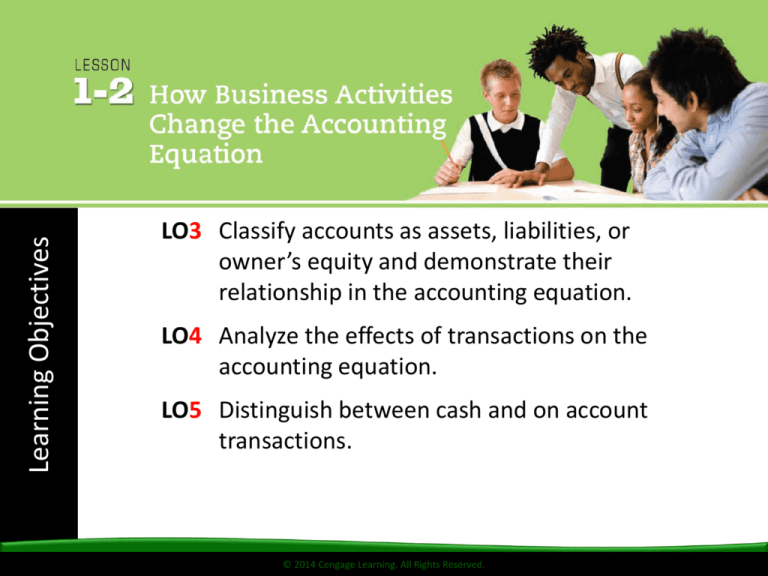
Learning Objectives
LO3 Classify accounts as assets, liabilities, or
owner’s equity and demonstrate their
relationship in the accounting equation.
LO4 Analyze the effects of transactions on the
accounting equation.
LO5 Distinguish between cash and on account
transactions.
© 2014 Cengage Learning. All Rights Reserved.
Lesson 1-2
The Business—Delgado Web Services
● A business that performs an activity for a fee
is called a service business.
● A proprietorship is a business owned by one
person.
● A proprietorship is sometimes referred to as a sole
proprietorship.
● A business plan is a formal written document
that describes the nature of a business and
how it will operate.
© 2014 Cengage Learning. All Rights Reserved.
SLIDE 2
Lesson 1-2
Accounting Standards and Rules
● The standards and rules that accountants
follow while recording and reporting financial
activities are commonly referred to as
generally accepted accounting principles or
GAAP.
© 2014 Cengage Learning. All Rights Reserved.
SLIDE 3
Lesson 1-2
The Accounting Equation
LO3
● Financial rights to the assets of a business are
called equities.
● The amount remaining after the value of all
liabilities is subtracted from the value of all
assets is called owner’s equity.
● The equation showing the relationship among
assets, liabilities, and owner’s equity is called
the accounting equation.
© 2014 Cengage Learning. All Rights Reserved.
SLIDE 4
Lesson 1-2
The Accounting Equation
© 2014 Cengage Learning. All Rights Reserved.
LO3
SLIDE 5
Lesson 1-2
Receiving Cash
LO4
● Accountants call any business activity that changes
assets, liabilities, or owner’s equity a transaction.
● A record that summarizes all the transactions
pertaining to a single item in the accounting equation
is called an account.
● The name given to an account is called an account
title.
● The difference between the increases and decreases in
an account is called the account balance.
● An account used to summarize the owner’s equity in a
business is called a capital account.
© 2014 Cengage Learning. All Rights Reserved.
SLIDE 6
Lesson 1-2
Receiving Cash
LO4
Transaction 1
January 2. Received cash from owner as an investment, $2,000.00.
© 2014 Cengage Learning. All Rights Reserved.
SLIDE 7
Lesson 1-2
Paying Cash
LO4
Transaction 2
January 2. Paid cash for supplies, $165.00.
Transaction 3
January 3. Paid cash for insurance, $900.00.
© 2014 Cengage Learning. All Rights Reserved.
SLIDE 8
Lesson 1-2
Transactions on Account
LO5
● A person or business to whom a liability is
owed is called a creditor.
© 2014 Cengage Learning. All Rights Reserved.
SLIDE 9
Lesson 1-2
Transactions on Account
LO5
Transaction 4
January 5. Bought supplies on account from Canyon Office Supplies, $220.00
Transaction 5
January 9. Paid cash on account to Canyon Office Supplies, $100.00.
© 2014 Cengage Learning. All Rights Reserved.
SLIDE 10
Lesson 1-2
Lesson 1-2 Audit Your Understanding
1. Give two examples of service businesses in
your area.
ANSWER
Answers should include businesses that
perform activities for a fee, such as dry
cleaners, car washes, or landscapers.
© 2014 Cengage Learning. All Rights Reserved.
SLIDE 11
Lesson 1-2
Lesson 1-2 Audit Your Understanding
2. What must be done if a transaction increases
the left side of the equation?
ANSWER
The right side must also be increased.
© 2014 Cengage Learning. All Rights Reserved.
SLIDE 12
Lesson 1-2
Lesson 1-2 Audit Your Understanding
3. How can a transaction affect only one side of
the equation?
ANSWER
If one account is increased, another
account on the same side of the equation
must be decreased by the same amount.
© 2014 Cengage Learning. All Rights Reserved.
SLIDE 13
Lesson 1-2
Lesson 1-2 Audit Your Understanding
4. What does the term on account mean?
ANSWER
Purchasing on account means buying items
or services and paying for them at a future
date.
© 2014 Cengage Learning. All Rights Reserved.
SLIDE 14






